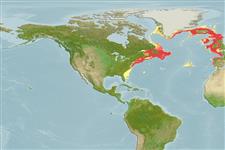Common names from other countries
Environment: milieu / climate zone / depth range / distribution range
Οικολογία
Πελαγικό(ά); εύρος βάθους 0 - 1000 m (Ref. 275). Tropical, preferred 21°C (Ref. 107945); 70°N - 26°N, 81°W - 2°W (Ref. 275)
Atlantic Ocean: British Isles north to Iceland and Greenland.
Length at first maturity / Μέγεθος / Βάρος / Age
Maturity: Lm ? range ? - ? cm Max length : 27.0 cm ML αρσενικό/απροσδιόριστο; (Ref. 275); 31 cm ML (female)
Maximum mantle length is 31cm (females) and 27cm (males) in the northern part of its distributional range, but 20 cm (females) and 18cm (males) in the southern part (Ref. 3722). Feeds on euphausiids, capelin, herring, juvenile mackerel (Ref. 275).
Life cycle and mating behavior
Γεννητική Ωρίμανση | Αναπαραγωγή | Γεννοβολία | Αβγά | Γονιμότητα | Προνύμφες
Members of the class Cephalopoda are gonochoric. Male and female adults usually die shortly after spawning and brooding, respectively. Mating behavior: Males perform various displays to attract potential females for copulation. During copulation, male grasp the female and inserts the hectocotylus into the female's mantle cavity where fertilization usually occurs. Life cycle: Embryos hatch into planktonic stage and live for some time before they grow larger and take up a benthic existence as adults.
Roper, C.F.E., M.J. Sweeney and C.E. Nauen. 1984. (Ref. 275)
IUCN Red List Status (Ref. 130435)
CITES status (Ref. 108899)
Not Evaluated
Not Evaluated
Human uses
αλιεία: Εμπορικό(ά)
FAO - αλιεία: landings, species profile | FIRMS (Stock assessments) | FishSource | Η θάλασσα γύρω μας
Εργαλεία
Διαδικτυακές πηγές
Estimates based on models
Preferred temperature
(Ref.
115969): 0.7 - 11.5, mean 6.4 (based on 424 cells).
Ελαστικότητα
Υψηλό, ελάχιστος χρόνος για διπλασιασμό πληθυσμού < 15 μήνες (K=0.3-2.5).
Vulnerability
Low vulnerability (23 of 100).
